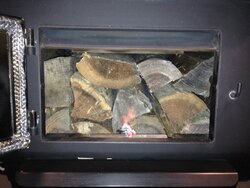Highbeam
Minister of Fire
Smoke will take the path of least resistance? Lame answer. Sure, most of the smoke will run through the cat but some will go through the gaps. If this was not a problem then we wouldn't need a bypass gasket or a cat gasket. Sure would make life easier.
We don't have a baffle in the BK. We have a bypass that is opened to allow the smoke an easier and more direct path to the flue that is more desirable than through the cat. Opening the bypass does not block the cat. We close the bypass to force all of the smoke through the cat. The cat is not terribly restrictive so I suspect that some flow is always passing through the cat.
I did a hot reload this morning. It was 17 degrees outside and I am on a 12 hour reload cycle now. It is unreasonable to expect operators to wait until the stove cools to reload a stove that is actually used for heat. So what I do is open the stat to full throttle, open the bypass, and leave it for two minutes while I collect fuel. Minimizing time that the loading door is open, I reload, close the door, let the new load ignite and char until the flue temps are climbing above 500, close the bypass, let it run on high for a few minutes and then reset the stat to the appropriate cruise setting. This whole time the cat probe reads active, in fact over 50% on the dial.
These things aren't decorative, they are heating appliances.
Closing the baffle stops air from running through the cat, correct? I would think closing the baffle and waiting 2 minutes, in a hot stove, will not cool the cat to any great extent but possibly that is the answer. Just closing the baffle should stop the air from rushing through it, forget the time frame.
We don't have a baffle in the BK. We have a bypass that is opened to allow the smoke an easier and more direct path to the flue that is more desirable than through the cat. Opening the bypass does not block the cat. We close the bypass to force all of the smoke through the cat. The cat is not terribly restrictive so I suspect that some flow is always passing through the cat.
I did a hot reload this morning. It was 17 degrees outside and I am on a 12 hour reload cycle now. It is unreasonable to expect operators to wait until the stove cools to reload a stove that is actually used for heat. So what I do is open the stat to full throttle, open the bypass, and leave it for two minutes while I collect fuel. Minimizing time that the loading door is open, I reload, close the door, let the new load ignite and char until the flue temps are climbing above 500, close the bypass, let it run on high for a few minutes and then reset the stat to the appropriate cruise setting. This whole time the cat probe reads active, in fact over 50% on the dial.
These things aren't decorative, they are heating appliances.


 might have been saying that moisture would be a problem as far as the cat's ability to light off, not that it would actually harm the cat. The cat doesn't have to be "babied" much. I think the only way to destroy a steel cat would be to overfire it often, or for an extended period, or burn materials other than cordwood in the stove, which could poison the catalyst wash coat.
might have been saying that moisture would be a problem as far as the cat's ability to light off, not that it would actually harm the cat. The cat doesn't have to be "babied" much. I think the only way to destroy a steel cat would be to overfire it often, or for an extended period, or burn materials other than cordwood in the stove, which could poison the catalyst wash coat.
 . I have noted this also when it gets colder it burns quicker at the same setting. As you noted baffle may not be the right word for how this stove works.
. I have noted this also when it gets colder it burns quicker at the same setting. As you noted baffle may not be the right word for how this stove works.